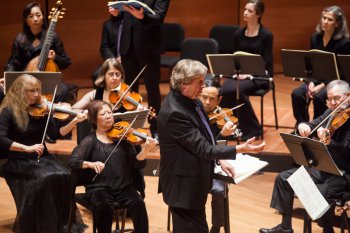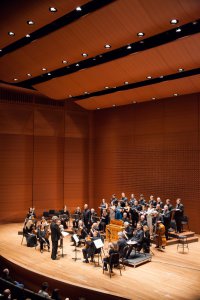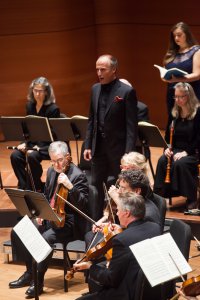American Classical Orchestra and Chorus: Johann Sebastian Bach’s Saint John Passion
A masterful performance of coherent artistic vision and intense musical integrity.
[avatar user=”Jean Ballard Terepka” size=”96″ align=”left” ] Jean Ballard Terepka, Music Critic[/avatar] The November 2015 presentation by the American Classical Orchestra and Chorus, founded and directed by Thomas Crawford, of Johann Sebastian Bach’s Saint John Passion was wonderful: Bach would have recognized his own notes, his instruments, and even, I believe, his intentions.
Thomas Crawford’s forty-years-long commitment to the performance of Baroque music on period instruments has yielded a coherent sound that, far from any arcane fussiness, is clean, warm and organic. Crawford’s distinguished orchestra musicians – many of whom had “soloist” moments as they played with singers in individual arias – invite listeners into the experience of their instruments.
Similarly, the chorus is superbly skilled at Baroque singing, both individually and as a group: they are consistently well balanced and as effectively responsive to Crawford’s direction as the orchestra.
The performance of the Saint John Passion was preceded by one of the pre-concert talks for which Crawford is well-known and respected. Crawford emphasized several elements of this work which he found especially rewarding in this particular experience of conducting the work: the last time Crawford conducted it was well over a decade ago. Using distinguished recordings as examples, he discussed passages of the Passion, emphasizing that “Bach is above all else a contrapuntal composer” and exploring Bach’s ability to make “time pass” at different speeds and paces in several lines – a cantus firmus, a voice in song, instruments swift-dancing above both, for instance – all at once. Crawford noted, too, that conductors take vastly different interpretations of Bach’s indicated fermatas; in the performance, Crawford was then true to his promise that, by and large, he would observe Bach’s fermatas only as they cohered with the meaning of the individual texts being sung.
This attention to Bach’s Lutheran text was at the center of two great strengths of this performance. First, the German diction of chorus and soloists alike was superb. Second, in arias as well as choral singing, the orchestra never overwhelmed the singers.

American Classical Orchestra and Chorus with Conductor Thomas Crawford (Photo credit: Arlette Landestoy)
From the beginning, tenor Rufus Muller as the Evangelist was marvelous. It is a role with which he is more than familiar as he has performed it frequently in this country and in Europe. Singing entirely without a score, he was absolutely compelling as the narrator who must tell the story of Jesus’ betrayal, interrogation and execution: he was at every moment thrilling, stretching his voice without strain or loss of credibility, a man torn between the drive to factual veracity and the anguish of remembered horror.
All of the other soloists were, in fact, members of the American Classical Orchestra Chorus, and in exceptionally well-organized stage direction, they moved gracefully from the chorus risers to a soloists’ platform near the Evangelist on stage right. Some of the soloists’ performances were particularly noteworthy.
Baritone Paul Max Tipton was a very fine Jesus: he was an unshakably courageous man whose kingliness was unerringly dignified. This Jesus’ divinity was evident only at the end, when his “Es ist vollbracht” was not a human groan of pain but an utterance of ethereality. Jesus’ terse elegance in the interrogation was a first rate dramatic match for baritone Kelvin Chan’s Pilate, a strong officer of the empire whose nerve in the face of the unintelligible did not break until he was confronted by the capricious, angry crowd. Tipton and Chan’s equally strong voices, each capable of rich resonance, set up a particularly tense drama in Pilate’s interrogation of Jesus.
Soprano Teresa Wakim sang her two arias beautifully. The ravishing “Ich folge du gleichfalls mit freudigen Schritten” of Part I – accompanied wonderfully by flutes and cellos – was a happy outpouring of joyful worship. In Part II, the dancing lyricism of Wakim’s voice was transformed after Jesus’ death on the cross into an intimate heartbreak, grief almost – but not quite – breaking the capacity for prayer.
In Part I, tenor Steven Caldicott Wilson used his strong, eloquent voice in “Ach, mein Sinn” to depict a manly man, unnerved and horrified by what he has seen. In Part II, tenor Dann Coakwell sang “Erwage, wie sein blugefarbter Rucken” gorgeously, as though reacting on-the-spot to what he has witnessed and simultaneously reflecting on it long afterward, a revelation of the transformation of his soul over time … and a subtle, elegant musical depiction of the salvational theology contained in the mere six lines of this aria, moving from the pouring blood on Jesus’ back to the shining rainbow of God’s grace.

American Classical Orchestra and Chorus with Conductor Thomas Crawford as they appeared at Alice Tully Hall (Photo credit: Arlette Landestoy)
The choral singing, excellent throughout, was especially fine in two areas. The prodigiously tough fugues – based on viciously litigious texts – were executed with none of the flaws of sloppiness that sometimes plague larger choruses.
The chorales were beautiful. Because of the genius of Bach’s writing and the graceful discipline of the ACO Chorus, audience members familiar with the hymns on which the chorales are based could hear their own singing of lines and lyrics they knew inside their own heads and hearts … much as members of Bach’s congregations might have in Leipzig in 1724.
Altogether, this was a presentation of musical elegance and integrity. It was also a loving performance by artists who have lived much of their professional lives in Bach’s music.
At the end of the concert, bouquets of flowers were brought on stage; Crawford himself distributed individual bright blooms to members of the orchestra and singers. The audience was on its feet.
Together with the ACO presentation of Telemann’s Der Tag des Gehrichts last month, this Bach performance contributes to Crawford’s position of leadership in the current dynamic and burgeoning field of historically accurate period performance.
How lucky New York City audiences are!
American Classical Orchestra and Chorus: Johann Sebastian Bach’s Saint John Passion (November 3, 2015)
Alice Tully Hall at Lincoln Center
1941 Broadway at 65th Street, in Manhattan
For more information, call 212-362-2727 or visit http://www.aconyc.org
Running time: two hours and ten minutes including one intermission







Leave a comment